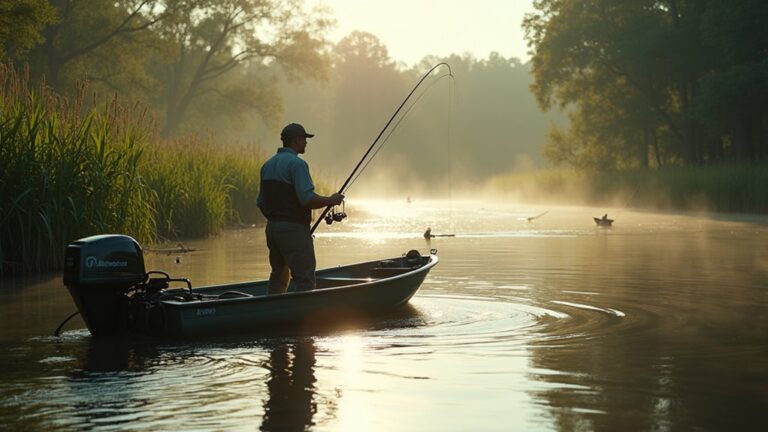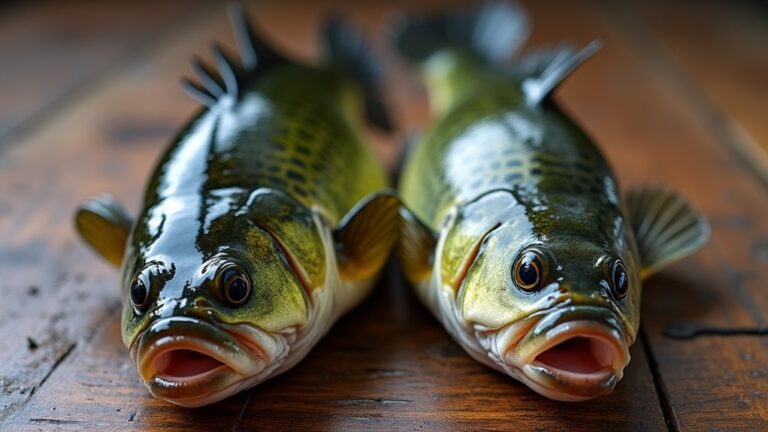If you're getting into surf fishing, you can target exciting species like striped bass, redfish, and bluefish. Look for them near jetties, piers, and rocky structures, especially during the early mornings or late afternoons when they're most active. Use sturdy gear along with sharp hooks and abrasion-resistant line. Experiment with different baits like live shrimp or fresh cut mullet to attract fish. Pay attention to tides and weather patterns, as they can greatly influence your success. Curious about the best techniques and spots for each fish? Keep going to discover even more fishing secrets and tips!
Best Surf Fishing Locations
When it comes to surf fishing, choosing the right location can make all the difference in your success. You'll want to look for areas where the fish are likely to congregate, which often includes spots near jetties, piers, and rocky structures. These places provide shelter and a food source for various saltwater fish.
Don't overlook the surf zones where breaking waves create currents. These currents can attract baitfish, and where there are baitfish, larger fish aren't far behind. Early mornings and late afternoons are prime times to fish these areas, as many species are more active during these hours.
Another excellent choice is estuaries and inlets where freshwater meets saltwater. These spots often yield a diverse range of fish, including flounder and striped bass.
If you're near a beach with shifting sands, check for sandbars or troughs, as they can create ideal feeding grounds.
Essential Gear for Surf Fishing
Choosing the right location is just the first step in a successful surf fishing trip; having the right gear is equally important. The gear you select can make a significant difference in your fishing experience. To help you prepare, here's a quick overview of crucial gear you shouldn't overlook:
| Gear Type | Purpose |
|---|---|
| Fishing Rod | Long and sturdy for casting into the surf |
| Reel | A saltwater reel that can handle larger fish |
| Fishing Line | Strong, abrasion-resistant line (e.g., braided) |
| Hooks | Sharp and durable, appropriate for target fish |
| Bait | Live or artificial bait suited for your target |
In addition to this gear, consider bringing a tackle box, landing net, and a fishing license. Don't forget about sun protection, like sunscreen and hats. A comfortable chair or beach umbrella can make your time more enjoyable. Having the right equipment will not only enhance your fishing success but also keep you safe and comfortable while you wait for that big catch. Make sure you pack wisely and enjoy your time by the waves!
Targeting Striped Bass
Targeting striped bass can be an exhilarating experience for surf anglers enthusiastic to land this prized fish. To increase your chances of success, you'll want to focus on specific times and locations. Striped bass are often most active during dawn and dusk, so plan your fishing trips around these golden hours.
Look for areas with structure, like jetties, piers, or rocky outcrops, as these spots tend to hold fish.
When it comes to bait, live eels, chunked menhaden, or fresh cut bait work wonders. If you prefer lures, try using topwater plugs or bucktail jigs, especially when the fish are feeding near the surface.
Don't forget to adjust your retrieve speed based on the conditions; sometimes a slow, steady retrieve works best, while other times, a fast-paced approach is more effective.
Catching Redfish Effectively
After you've had your fill of chasing striped bass, redfish can offer a thrilling change of pace for surf anglers. These feisty fish are known for their aggressive strikes and strong fights, making them a popular target along the coast.
To catch redfish effectively, start by choosing the right time; early mornings or late evenings are usually most productive.
When it comes to bait, live shrimp, cut mullet, or even soft plastics can entice redfish. Cast your bait near the shore, especially around structures like jetties or sandbars where redfish tend to congregate.
Pay attention to the tides, as redfish often feed during moving water. A rising tide can be particularly effective, so plan your outings accordingly.
If you're using a rod and reel, opt for medium to heavy gear; you'll want to be prepared for a strong battle.
Lastly, don't forget to check local regulations and size limits to guarantee a responsible catch.
With the right approach, you'll find redfish can provide an exciting challenge that keeps you coming back for more. Happy fishing!
Techniques for Surf Perch
While surf fishing for perch can be less intense than chasing redfish, it offers its own unique rewards and challenges. To successfully catch surf perch, you'll want to focus on the right techniques and tackle.
Start by choosing a light spinning rod and reel combo, as this setup allows for better sensitivity and control.
When it comes to bait, fresh sand crabs, shrimp, or bloodworms work wonders. You can also use soft plastic grubs that mimic these natural baits.
Cast your line near the shore where the waves break, as perch often feed in the surf zone.
Pay attention to the tides; fishing during an incoming tide can increase your chances of success.
You'll also want to vary your retrieve speed—try a slow, steady pull, then experiment with short bursts to see what entices the fish.
Use a simple rig, like a Carolina rig or a high-low rig, to keep your bait in the strike zone.
Tips for Bluefish Fishing
Surf fishing can lead you to a variety of species, and if you're ready for a more exhilarating experience, bluefish are a fantastic target. These aggressive feeders are known for their strong fight, making your time on the water unforgettable.
To increase your chances of success, consider fishing during their peak feeding times, typically early morning or late afternoon. Use a fast-action rod paired with a sturdy reel, as bluefish can put up a serious fight.
When it comes to bait, fresh cut bait like mackerel or squid works wonders, but don't overlook lures such as metal spoons or poppers that mimic smaller fish.
Cast your line where there's surf action, as bluefish often hunt in schools near breaking waves. Be prepared for a quick strike; they're known for their aggressive feeding behavior.
Once hooked, keep your line tight and be ready for acrobatic jumps and runs.
Understanding Flounder Behavior
Flounder are fascinating creatures that often lie in wait for unsuspecting prey on the sandy ocean floor. Their unique ability to camouflage themselves makes them exceptional ambush predators.
To effectively catch flounder, you need to understand their behavior and habits. Here are four key points to contemplate:
- Hiding Spots: Flounder prefer to stay near structures like rocks, jetties, or weed beds. Focus your fishing efforts around these areas, as flounder often use them for cover.
- Feeding Times: These fish are most active during low-light periods, such as dawn and dusk. Plan your fishing trips around these times for better chances of success.
- Movement Patterns: Flounder tend to move into shallower waters during the warmer months. Keep an eye on water temperature and adjust your fishing locations accordingly.
- Bait Selection: Live bait, such as minnows or shrimp, works wonders for attracting flounder. You can also use artificial lures that mimic their natural prey to entice them.
Timing Your Fishing Trips
Timing your fishing trips can greatly enhance your success on the water. To catch more fish, consider the tides. Fish are often more active during incoming or outgoing tides, as the movement of water stirs up food and draws them closer to shore. Plan your trips around these tidal changes for ideal results.
Next, pay attention to the time of day. Early mornings and late afternoons typically offer the best fishing conditions, as fish are more likely to feed during these cooler periods. Overcast days can also be advantageous, as fish may venture out more with reduced light.
Seasonality plays an essential role too. Different species of fish have specific spawning and feeding habits throughout the year. Research the peak seasons for your target species, and time your trips accordingly.
Lastly, keep an eye on the weather. A sudden change can trigger fish activity, so be prepared to capitalize on those moments.
Conservation Practices for Anglers
Conservation practices are essential for ensuring that our oceans remain vibrant and fish populations thrive for future generations.
As an angler, you have a significant role to play in protecting marine ecosystems. Here are some simple yet effective practices you can adopt during your surf fishing trips:
- Practice Catch and Release: When possible, gently release fish you don't plan to keep. Use barbless hooks to minimize injury and handle fish with wet hands to protect their slime coating.
- Be Mindful of Regulations: Stay updated on local fishing regulations, including size and bag limits. These rules are designed to help maintain healthy fish populations.
- Reduce Plastic Usage: Bring reusable bags and containers to minimize your plastic footprint. Dispose of trash properly, as plastics can harm marine life.
- Respect Habitats: Avoid disturbing nesting areas and sensitive ecosystems. Stay on designated paths and be mindful of dune structures and vegetation.
Conclusion
In the world of surf fishing, knowing your target species and their habits can make all the difference. By using the right gear and techniques, you'll be well on your way to reeling in a big catch. Remember, it's not just about the fish; it's about enjoying the experience and the great outdoors. So, take the plunge and put these tips into action—who knows, you might just hook the catch of the day!




